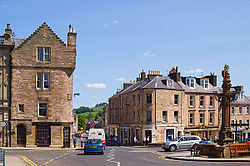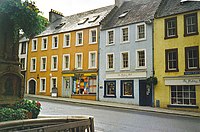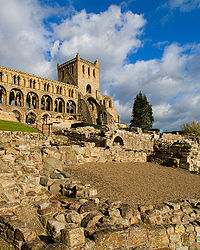Jedburgh: Difference between revisions
m →Sights in the town: clean up, replaced: medieval → mediæval |
|||
| (One intermediate revision by the same user not shown) | |||
| Line 25: | Line 25: | ||
==Jedburgh Abbey== | ==Jedburgh Abbey== | ||
The ruined abbey is maintained by [[Historic Scotland]] and opened to the public. It was the site of a major archaeological dig in 1984. Many of the more important finds from the excavation are displayed on site in the modern visitor centre attached to the Abbey ruins. The Abbey, though much damaged over the years by war and its 450 year abandonment from the Reformation, is still one of the finest late Norman buildings remaining in Scotland. | The ruined abbey is maintained by [[Historic Scotland]] and opened to the public. It was the site of a major archaeological dig in 1984. Many of the more important finds from the excavation are displayed on site in the modern visitor centre attached to the Abbey ruins. The Abbey, though much damaged over the years by war and its 450-year abandonment from the Reformation, is still one of the finest late Norman buildings remaining in Scotland. | ||
Now roofless, part of the church was used as the parish church into the 19th century. | Now roofless, part of the church was used as the parish church into the 19th century. | ||
| Line 40: | Line 40: | ||
[[File:Jedburgh Market Place.jpg|right|thumb|200px|Market Hill]] | [[File:Jedburgh Market Place.jpg|right|thumb|200px|Market Hill]] | ||
Jedburgh Castle Gaol, built in the early 19th century on the site of the | Jedburgh Castle Gaol, built in the early 19th century on the site of the mediæval castle, is also open to the public. | ||
The Canongate Brig dates from the 16th century, and there are some fine riverside walks. The Capon Oak Tree is reputed to be 2,000 years old, and Newgate Prison and the town spire are among the town's older buildings. | The Canongate Brig dates from the 16th century, and there are some fine riverside walks. The Capon Oak Tree is reputed to be 2,000 years old, and Newgate Prison and the town spire are among the town's older buildings. | ||
| Line 68: | Line 68: | ||
In 1745, the Jacobite army led by Prince Charles Edward Stuart, the Young Pretender, passed through the town on its way to England, and the Prince also stayed here. | In 1745, the Jacobite army led by Prince Charles Edward Stuart, the Young Pretender, passed through the town on its way to England, and the Prince also stayed here. | ||
In 1787 the early geologist James Hutton noted what is now known as the Hutton Unconformity<ref name="VestigeProspectAMNH"/> at Inchbonny, near Jedburgh.<ref name=Jedwalks>{{cite web |url=http://www.scotborders.gov.uk/pdf/18695.pdf |title=Walks around Jedburgh |accessdate=2008-03-26 |author=Graphic Design Section|date=1999 |format= |work= |publisher=Scottish Borders Council}}</ref><ref>{{cite web |url=http://nagt.org/files/nagt/jge/abstracts/Montgomery_v51n5.pdf |title=Siccar Point and Teaching the History of Geology |accessdate=2008-03-26 |author=Keith Montgomery |date=2003 |format=pdf |work= |publisher=University of Wisconsin }}</ref> Layers of [[sedimentary rock]] which are tilted almost vertically are covered by newer horizontal layers of [[red sandstone]].<ref name="Unconformity Jedburgh">{{cite web |url= http://www.jedburgh-online.org.uk/aroundjedburgh.asp |title= Jedburgh: Hutton's Unconformity | In 1787 the early geologist James Hutton noted what is now known as the Hutton Unconformity<ref name="VestigeProspectAMNH"/> at Inchbonny, near Jedburgh.<ref name=Jedwalks>{{cite web |url=http://www.scotborders.gov.uk/pdf/18695.pdf |title=Walks around Jedburgh |accessdate=2008-03-26 |author=Graphic Design Section|date=1999 |format= |work= |publisher=Scottish Borders Council}}</ref><ref>{{cite web |url=http://nagt.org/files/nagt/jge/abstracts/Montgomery_v51n5.pdf |title=Siccar Point and Teaching the History of Geology |accessdate=2008-03-26 |author=Keith Montgomery |date=2003 |format=pdf |work= |publisher=University of Wisconsin }}</ref> Layers of [[sedimentary rock]] which are tilted almost vertically are covered by newer horizontal layers of [[red sandstone]].<ref name="Unconformity Jedburgh">{{cite web |url= http://www.jedburgh-online.org.uk/aroundjedburgh.asp |title= Jedburgh: Hutton's Unconformity |work= Jedburgh online |quote= Whilst visiting Allar's Mill on the Jed Water, Hutton was delighted to see horizontal bands of red sandstone lying 'unconformably' on top of near vertical and folded bands of rock. }}</ref> This was one of the findings that led him to develop his concept of an immensely long geologic time scale with "no vestige of a beginning, no prospect of an end."<ref name="VestigeProspectAMNH">{{cite web |url= http://www.amnh.org/education/resources/rfl/web/essaybooks/earth/p_hutton.html |title= James Hutton: The Founder of Modern Geology |author=American Museum of Natural History |work= Earth: Inside and Out |date= 2000 }}</ref> | ||
The Castle Prison was opened in 1823. | The Castle Prison was opened in 1823. | ||
Latest revision as of 09:20, 30 January 2021
| Jedburgh Scots: Jeddart, Jethart | |
| Roxburghshire | |
|---|---|
 Mercat Cross from Castle Hill | |
| Location | |
| Grid reference: | NT6520 |
| Location: | 55°28’37"N, 2°32’46"W |
| Data | |
| Population: | 4,090 |
| Post town: | Jedburgh |
| Postcode: | TD8 |
| Dialling code: | 01835 |
| Local Government | |
| Council: | Scottish Borders |
| Parliamentary constituency: |
Berwickshire, Roxburgh and Selkirk |
Jedburgh is a town and royal burgh in Roxburghshire. It stands on the Jed Water, a tributary of the River Teviot. It is only ten miles from the border with Northumberland, and is dominated by the substantial ruins of Jedburgh Abbey. Other notable buildings in the town include Mary, Queen of Scots' House and Jedburgh Castle Gaol, now a museum.
Jedburgh enjoys Borders traditions like the annual Callant's Rideout. Bands of pipes and drums add local colour, and delicacies of the town include Jethart Snails and Jethart Pears. Another annual event is the Jethart Hand Ba' game.
The town's industries included textiles, tanning and glove-making, grain mills, and electrical engineering.
Central to the festival and customs associated with the town of Jedburgh are the Jedforest Instrumental Band who support many civic, religious and social events throughout the year, a service provided consistently since 1854.
Jedburgh Abbey
The ruined abbey is maintained by Historic Scotland and opened to the public. It was the site of a major archaeological dig in 1984. Many of the more important finds from the excavation are displayed on site in the modern visitor centre attached to the Abbey ruins. The Abbey, though much damaged over the years by war and its 450-year abandonment from the Reformation, is still one of the finest late Norman buildings remaining in Scotland.
Now roofless, part of the church was used as the parish church into the 19th century.
Churches
- Church of Scotland:
- Old & Trinity Parish Church
- Scottish Episcopal Church: St John's
- Baptist: Jedburgh Baptist Church
- Roman Catholic: St Mary's
Sights in the town

Jedburgh Castle Gaol, built in the early 19th century on the site of the mediæval castle, is also open to the public.
The Canongate Brig dates from the 16th century, and there are some fine riverside walks. The Capon Oak Tree is reputed to be 2,000 years old, and Newgate Prison and the town spire are among the town's older buildings.
Surrounding area
Other towns of interest include Kelso, Hawick, Galashiels, Selkirk, and Melrose. There are abbeys at Melrose, Kelso and Dryburgh, and Kelso boasts a fine cobbled square.
All the border towns are famous for their rugby union. Galashiels has associations with William Wallace and Robert the Bruce. Selkirk is where William Wallace was declared "Guardian of Scotland" and has many links to the Earls of Douglas, where some of his descendents live to this day and Melrose was the scene of a battle in 1526 over the stewardship of James V.
History
A church had stood at Jedburgh since the 9th century, founded by Bishop Ecgred of Lindisfarne. The town belonged to Northumbria until the Norse incursions, whereafter it was part of the remnant English territory held by the High Reeves of Bamburgh. Some historians have identified Jedburgh as the Iudanburg in which King Edred imprisoned Wulfstan Archbishop of York for treason, though Stenton convincingly refuted this.[1] "Lothian" (the lands north of the Tweed) were ceded to the King of Scots in the early eleventh century but Jedburgh lies some miles south of the Tweed and seems to have passed to Scotland much later.
King David I of Scotland made the church into a priory between 1118 and 1138, housing Augustinian monks from Beauvais in France. The abbey itself was founded in 1147.
The deeply religious King, Malcolm IV died at Jedburgh in 1165, aged 24. His death was thought to be brought on by excessive fasting.
David I had also erected a castle at Jedburgh, and in 1174, it was one of five fortresses ceded to England. It was an occasional royal residence for the Scots but captured by the English so often that it was eventually demolished in 1409, when it was the last English stronghold in Scotland.

In 1258 Jedburgh had also been the focus of royal attention, with negotiations between Scotland's Alexander III and England's Henry III over the heir to the Scottish throne, leaving the Comyn faction dominant. Alexander III was also to marry at the abbey in 1285.
In 1397 King Robert III created George Douglas, 1st Earl of Angus “Lord of Jedburgh Forest”, a Lordship of Parliament, on the occasion of Douglas's marriage to the Princess Mary, the King's daughter. The title is now a subsidiary title of the present Earl of Angus, the Duke of Hamilton. The Duke of Douglas was raised to the position of Viscount Jedburgh Forest, but he died without heir in 1761.
Jedburgh's proximity to England made it historically subject to raids and skirmishes by both Scottish and English forces, and placed it deep in the lawless reiver country.
Mary, Queen of Scots, stayed at a house in the town in 1566 which is now a museum.
In 1745, the Jacobite army led by Prince Charles Edward Stuart, the Young Pretender, passed through the town on its way to England, and the Prince also stayed here.
In 1787 the early geologist James Hutton noted what is now known as the Hutton Unconformity[2] at Inchbonny, near Jedburgh.[3][4] Layers of sedimentary rock which are tilted almost vertically are covered by newer horizontal layers of red sandstone.[5] This was one of the findings that led him to develop his concept of an immensely long geologic time scale with "no vestige of a beginning, no prospect of an end."[2]
The Castle Prison was opened in 1823.
Jeddart justice
The expression "Jeddart justice" or "Jethart Justice" comes from the days of the reivers. It was alleged that at Jedburgh a captured man would be hanged first and tried afterward; something known in Devon as Lydford law. It is said to have been the way the town would deal with the lawless men of the Borders, or it might have arisen from one case of the summary execution of a gang of villains.
Jethart Snails
Jethart Snails are a local speciality; not a snail but a brown mint-flavoured boiled sweet. The recipe is believed to have been brought to the town by French prisoners of the Napoleonic War
Notes
- ↑ A History of England before the Norman Conquest, Sir Frank Stenton
- ↑ 2.0 2.1 American Museum of Natural History (2000). "James Hutton: The Founder of Modern Geology". Earth: Inside and Out. http://www.amnh.org/education/resources/rfl/web/essaybooks/earth/p_hutton.html.
- ↑ Graphic Design Section (1999). "Walks around Jedburgh". Scottish Borders Council. http://www.scotborders.gov.uk/pdf/18695.pdf. Retrieved 2008-03-26.
- ↑ Keith Montgomery (2003). "Siccar Point and Teaching the History of Geology" (pdf). University of Wisconsin. http://nagt.org/files/nagt/jge/abstracts/Montgomery_v51n5.pdf. Retrieved 2008-03-26.
- ↑ "Jedburgh: Hutton's Unconformity". Jedburgh online. http://www.jedburgh-online.org.uk/aroundjedburgh.asp. "Whilst visiting Allar's Mill on the Jed Water, Hutton was delighted to see horizontal bands of red sandstone lying 'unconformably' on top of near vertical and folded bands of rock."
Sources and outside links
- Gazetteer for Scotland: Jedburgh
- RCAHMS record of Jedburgh
- Jedburgh Town Website Website
- Jedburgh Brass band (Jedforest Instrumental) Website
- Jedburgh Online Community Website
- Jedburgh Attractions
- Lyrics and a recording of the Victorian song 'Jedwater' by David Kilpatrick, Traditional Music and Song Association Scottish Borders branch